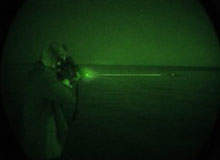
Much of the war in Afghanistan is being fought at the ground level, with coalition forces seeking to nullify Taliban guerrillas in urban and rural areas.
The coalition is seeking to gain an edge on the battlefield by developing new types of explosives and ammunition. With relatively small investment, innovation in this area can dramatically enhance combat effectiveness.

Discover B2B Marketing That Performs
Combine business intelligence and editorial excellence to reach engaged professionals across 36 leading media platforms.
High-explosive ammunition
In recognition of this trend, Combined Systems (CSi), which supplies non-lethal crowd control systems, launchers, pyrotechnics and tactical munitions around the world, signed an agreement in 2009 to exclusively manufacture, market and sell FRAG-12. This system of high-explosive ammunition is designed to nulllify targets protected by hardened or reinforced materials.
Richard Edge, CSi’s chief operating officer, remarked that FRAG-12 was “a game changing technology for the warfighter engaged in urban combat”. FRAG-12 shotgun rounds are designed to improve the combat effectiveness of shotguns in urban areas, where it might be used to stop vehicles at roadblocks and checkpoints, during barricade attacks, or for the remote probing of potential improvised explosive devices.
High-explosive rounds are capable of making a 1in hole in cold-rolled steel plate ¼in thick. The maximum effective range for this round is claimed to be 200m, a significant improvement for the effective range of a standard shotgun.
Enhanced Performance
Meanwhile, ATK Armament Systems, the world’s largest manufacturer of military ammunition and integrated medium-calibre gun systems, has developed the new M855A1 Enhanced Performance Round (EPR) for the US Army.

US Tariffs are shifting - will you react or anticipate?
Don’t let policy changes catch you off guard. Stay proactive with real-time data and expert analysis.
By GlobalDataThe EPR replaces the M855 5.56mm cartridge that has been used by US troops since the early 1980s. In October 2010, ATK received an order for 300 million rounds from the Pentagon, but it had been in use in Afghanistan since early 2010.
According to ATK, the new round offers a higher velocity, which provides improved hard-target capability in addition to greater accuracy and consistency at long range. It also reduces muzzle flash, all of which has led the US Army to describe it as “the most significant advancement in general purpose small caliber ammunition in decades”.
Project manager Chris Grassano said the new round was “the culmination of an army enterprise effort by a number of organisations”, which included the Army Research Laboratory, Armament Research Development and Engineering Center, Program Executive Office for Ammunition and Joint Munitions Command.
The M855A1 round is sometimes referred to as “green ammo” – far less lead is used in the manufacturing process, hence its environmentally friendly credentials. Ammunition, most of which contains lead and other toxic material, is subject to the increasingly stringent environmental requirements facing most other products, and suppliers such as ATK are far from alone in adapting their goods. Swedish ammunition supplier Nammo, for example, supplies lead-free ammunition in the form of the 5.56x45mm Ball and 7.62x51mm Ball and Tracer, which have been in service for several years.
Tracer trajectory
Nammo has also been taking the lead in developing a new generation of tracer bullets. The company points out that today’s battles are often fought in complete darkness, and that night vision devices have become more effective, smaller and widely available in recent years.
Soldiers have used conventional tracers to see where rounds impact at night, but Nammo has introduced another option – the Nammo IR tracer. This ammunition is totally invisible to the naked eye and produces no muzzle flash or traces, which would otherwise allow an enemy soldier to identify who is firing them. It thus gives soldiers “stealth” capabilities.
Supply issues
The US may become increasingly reliant on foreign ammunition suppliers such as Nammo, according to a report from the US General Accounting Office published in January 2011. It found that US forces are now using 1.8 billion rounds of small-arms ammunition a year. The total has more than doubled in five years, largely as a result of the wars in Afghanistan and Iraq, as well as changes in military doctrine.
At present, the military is reliant on just three government-owned, contractor-operated plants that produce small and medium-calibre ammunition. The plants, all built in 1941, have been unable to keep up with increasing demand.
Israel Military Industries is one of the foreign suppliers the Pentagon is now using. The company has a number of advanced small-calibre products including the 120mm STUN, M337 Cartridge – a non-lethal tank round for use in low intensity conflicts. It creates a flash, explosion and blast effect similar to service ammunition, and is designed to deter violent protests.





